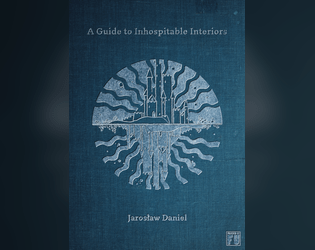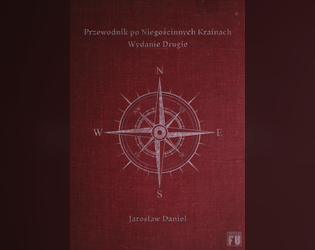Cool, let me know if it proved useful! :)
Castelviator
Creator of
Recent community posts
Ironsworn is a role-playing game (RPG) created by Shawn Tomkin. The premiere took place in 2018, and even earlier the author released a beta version, which already at this stage aroused some interest in the RPG community. It certainly belongs to the narrative kind of RPG.
The game offers 3 modes: classic guided play, with Game Master and players, cooperative, where all participants control their characters and at the same time co-shape the narrative, and solo mode. This means that the game has unusual approach to separation of powers. I’ve played all 3 modes, so I can confirm that they all work very well.
The manual has 272 pages and is black and white (except for the cover). The electronic version (PDF) can be downloaded for free on the author’s website, the DriveThruRPG portal (where it has been the most popular free game for years) or on itch.io. In 2019, Ironsworn won the ENnie Award for Best Free Game.
Who and where are we in this game?
We take the role of the titular Ironsworn – wandering heroes who undertake difficult and dangerous quests, swearing an oath on iron. Quests can result from personal motivation (e.g. revenge on the enemy), as well as be a form of payment for a favor or a spontaneous reaction to injustice – for example, our hero can wander into a village whose inhabitants live in poverty because of tribute paid to bandits, and decide to relieve them of this burden. Vows are the main driving force of the action, and fulfilling them is the only way to gain experience points and thus develop the character.
The action takes place in the Ironlands – a harsh land whose landscapes and level of technological development evoke associations with Scandinavia of the early Viking Age. Personally, it also reminds me of the northern reaches of Westeros and, to a lesser extent, Skyrim.
In many RPGs, the setting is either described very precisely, as in the case of the Old World in Warhammer, or vice versa – it is created from scratch by players in systems such as Fate, FU (Freeform Universal RPG), PbtA games (Powered by the Apocalypse, i.e. inspired by the groundbreaking Apocalypse World system). Shawn Tomkin, however, opted for the “middle option”. The Ironlands are outlined in the manual (the relevant chapter is only 20 pages, not including the bestiary), and players fill out their version of the realm with personally created details. The land consists of 9 characteristic regions – from the coast full of fjords, through dense forests, to the extremely unfriendly ice wastelands, which are the northern border of this continent. I consider the description of these regions to be a masterpiece – for each there is only half a page of text and one photo, but it is enough to feel the atmosphere of a given place and remember how it differs from the others.
At the beginning of the campaign, players define several Truths about the world – in each case they can choose one of the 3 proposed options or come up with their own. For example, you need to determine whether the Firstborn (i.e. elves, trolls and giants) in our version of the Ironlands are just a legend, or small and isolated populations, or maybe they are the dominant ones and humans are the minority.
Creating a character is simple – we have 5 attributes to which we assign values: 3, 2, 2, 1, 1. In addition, we choose 3 out of 75 Assets divided into 4 categories: Companion, Path, Combat Talent, Ritual. In Ironsworn, you don’t have to choose between being a warrior, a druid or a mage. You can choose, for example, one Combat Talent Asset (such as a Shieldbearer or an Archer), a faithful animal Companion and some climatic Nordic Ritual. Assets should not be repeated in the party – thanks to this, each member has unique abilities.
Experience points earned by fulfilling Iron Vows can be spent to upgrade our Assets or obtain new ones.
How do we act
As in PbtA games, the actions of heroes take the form of Moves, of which there are 35 in this system. When a character does something that triggers one of them (e.g. reacting to danger, resupplying or setting up camp in the wild), the player rolls 3 dice: 1 six-sided (d6) and 2 ten-sided (d10), here called challenge dice. To the result on d6, the player adds the value of one of the attributes (and sometimes other bonuses, e.g. those resulting from Assets), and compares the resulting sum (the so-called action score) with the numbers that came out on d10.
If the action score is higher than the score on both challenge dice, we have a strong hit. The character achieved exactly what they set out to do. If the action score is higher than the result of only one of the challenge dice, we have a partial success (weak hit) – the action was at least partially successful, but there were also unforeseen complications. However, if the results of both d10s are higher than the action score – it means a defeat (miss). This can be taken literally as a failure of the character’s actions, or the character may have achieved what they intended after all, but serious complications are introduced at the same time. Shawn used this example: if a hero is trying to track a monster and the player fails the roll, it doesn’t necessarily mean the trail is lost. Instead, the hero may discover something that makes his situation more dangerous or complicated, such as that one of his tribesmen is in concert with the monster. According to my calculations, depending on the amount of the given attribute and other bonuses, the risk of miss ranges from 9% to 45%. It is usually closer to the latter value.
Ironsworn’s mechanics are designed in such a way that heroes can easily get into serious trouble, but at the same time they rarely die. This creates a constant atmosphere of peril. For example: each character has only 5 Health points, which are very easy to lose, but this does not mean immediate death – when we take further damage, we must either accept receiving a serious wound that hinders some actions, or roll 2d10 and read the result in a special table. Some of its results may force us to roll a special Move called Face Death, and only failure in the latter means the hero’s sad end. Interestingly, one of the animal companions, the raven, can give a +2 bonus to the Face Death roll and thus significantly increase the chance of getting out of trouble.
How we fulfill our Vows
Each Iron Vow has a progress track consisting of 10 empty squares. It also has one of 5 ranks, from Troublesome (e.g. getting healing herbs in the nearby forest) to Epic (carrying a powerful magical ring to a volcano in a cursed land :) ).
Some of the hero’s actions, such as overcoming a dangerous obstacle, going on a journey, fighting a fight, solving a mystery, obtaining a valuable item, or supporting another character or the entire community, if directly related to the fulfillment of the Vow, may be considered a milestone. In this case, progress is made on that Vow track: from 3 full squares for Troublesome to a quarter square for Epic.
What is important: the progress track does not have to be completely filled! At any time (so long as the plot fits) the player can attempt to complete the mission by rolling the Fulfill Your Vow Move. In this case, they roll only 2d10 dice and compare the results with the number of fully filled squares (instead of the action score). The result is considered in the same way as in the case of other Moves: the task may therefore be crowned with a complete success (and earning from 1 to 5 experience points depending on the Vow rank) or it may turn out that something more needs to be done (in which case we receive a smaller reward and we can swear another Iron Vow to complete the work – but we don’t have to). We can also fail, which means a powerful blow to our Spirit (psychic equivalent of Health points – in extreme cases it can lead to madness of the character) and a potential crisis in the relationship with the person we swore to. With 4 filled squares, the risk of failure is 49%, with 6 – 25%, with 10 – 1% (there can always be two 10s!).
It may happen that when we ask someone for help in our task, that person will support us, provided we do something for them. In this way, a side quest may appear, the successful completion of which will also mean reaching a milestone in the main quest. Several quests tend to be active at the same time.
Not only quests have progress tracks – combat, travel, and dungeon exploration (introduced in the Delve expansion) are also resolved in the same way. All of these activities have 1 out of 5 ranks, and by hitting enemies or completing the next stages of your journey, you mark your progress. At the selected moment (not necessarily after filling the entire track!) we check whether we won the fight (or the enemy had some ace up his sleeve) or whether we reached the destination (or maybe it turned out that we took a wrong road or that our destination was destroyed before we reached it).
This mechanic makes it virtually impossible to railroad (i.e. remove agency from players by the Game Master), and it forces improvisation!
The Game Master cannot impose:
1. what Vows will the Players’ Characters swear (although GM can and should create situations conducive to swearing them, e.g. NPCs asking for help), whether they will choose to fight, go on a journey;
2. when they decide that they are ready to try to fulfill the oath, end the fight, reach the destination;
3. if they succeed (it depends on the roll).
Whom and how we fight?
Now that I’ve mentioned combat, let’s move on to the essential part of many RPG manuals, namely the bestiary. As with the Ironlands regions, there is 1 page for each of the 29 potential enemies. However, forget about solutions from classic RPGs, where each creature is described in terms of the number of hit points, armor, resistances, number and strength of attacks, etc. In Ironsworn, each creature except Player Characters has only 1 stat, namely the rank, which determines the pace of filling the progress track with successful blows and the damage that the creature deals to our heroes.
As I mentioned, the rank system is consistent across all elements of the game, so we have a cross-section of Troublesome-ranked enemies like Marsh Rats to Epic-ranked Leviathan lurking in the depths of the sea. However, the rank is not immutable. When facing a group of low-ranked opponents, we can give them one higher-ranked progress track to simplify bookkeeping. However, if we are supported by a squad of allied NPCs, we can lower the rank of the opponent – without it, we have no real chance against the strongest ones.
Creature descriptions are not limited to rank. The manual also includes the characteristics of their appearance and behavior, including their preferred tactics. For example, wild boars usually charge at their prey, while giant spiders prefer to catch it in a web or surprise it with an attack from above.
During combat, the key element is initiative – if the previous Character’s Move was resulted in strong hit, then the initiative belongs to the Character and the player can perform the most advantageous Strike Move. However, if the last Move was not a strong hit, then the opponent acts (probably using one of their favorite tactics, we can also randomise its behavior with a special table), and the Character needs to react, e.g. by dodging (i.e. Face Danger Move). In the absence of initiative, the Character can also counterattack with Clash Move, but the consequences of failure are more severe than in the case of Strike.
This way, none of the participants (players or Game Master, if any) roll for the opponents – enemies succeed when Characters’ Moves, whether aggressive or reactive, fail.
How we answer questions
You already know that Ironsworn can be played without a Game Master. The question arises: who and how creates the locations, NPCs and challenges faced by the Player Characters?
The answer is Oracles, a set of 20 random tables. They answer most of the questions players and their Ironsworn players may have. For example, let’s look at Oracles 4 and 6:
Let’s assume that our Characters are traveling and we want to determine what characteristic waypoint appears to their eyes. We roll a d10 4 times. The first 2 results give us tens and digits from the Oracle number 4 – we got 2 and 1, which is 21 – this means Cave. The second pair of rolls is for Oracle number 6 – a 3 and a 6 are rolled, which is 36, so the cave is Occupied! By whom? The answer may be the first thought that comes to mind, or we may ask another Oracle. After that, the only thing left to do is to decide whether we should avoid the inhabitants of the cave, try to communicate with them (e.g. by performing the Compel Move) or fight them.
Oracles have a good reputation – they are used not only by people playing Ironsworn, but also other systems, as an additional, helpful tool.
Do we enjoy?
Ironsworn is a very specific game. Even RPG players who are used to PbtA games may need some time to learn how progress tracks or Initiative rules work. People who have never dealt with PbtA may be completely confused at first. I think it’s worth learning the game though. Shawn Tomkin designed it with the utmost care – the rules perfectly match the assumed mood of a harsh land full of dangers, but also honorable, brave heroes. Once we get used to the unusual rules, the gameplay is very fluid. The manual is perfectly clear, thanks to the index we can quickly find the aspect of the game we are interested in, and the PDF version is full of hyperlinks, so one click takes us straight to the desired section of the book. In addition, we have an 11-page Playkit containing, among others: a summary of the basic rules, a description of Moves and a character sheet.
In conclusion, I highly recommend Ironsworn if:
1. you like a narrative approach to RPGs (as opposed to tactical battles with figures and a grid);
2. you like Viking vibes;
3. you prefer mystical rituals (mostly divination and curses) rather than throwing fireballs left and right;
4. you are not afraid of challenges;
5. you don’t have a willing Game Master on hand or you just want to try an unusual form of gameplay.
I advise against this game if:
1. you want to play safety-conscious, cynical, non-empathic characters – in Ironsworn it won’t work, the characters have to be quite eager to swear Iron Vows to the people they meet (i.e. voluntarily get into new, potentially deadly trouble) to drive the action;
2. you are bothered by a very abstract approach to inventory, prices, trade, etc.;
3. you prefer tactical combat, with movement range calculation, counting bullets, etc.
Ironsworn has a dedicated fanbase. The official Discord server has over 8000 members, a bit more can be found on the relevant subReddit, and over 2,500 on the Facebook group. On Twitter, Shawn Tomkin has almost 5,300 followers. There are countless blogs with session reports and YouTube streams, most recommended by me is Me, Myself and Die! Season Two.
The Ironsworn community is very beginner-friendly and creative. Although the basic rulebook discussed in this text is more than enough to play a lot of adventures, fans have created many interesting additions. This is facilitated by the open license of the game. The author himself did not stop at his debut work either. But I will tell you about the additions another time.
In February 2023, i.e. about 5 years after the game’s release, Shawn Tomkin announced its second edition on the aforementioned Discord server – initially for 2025, and playtests are to start this year. The new version of the game is to include numerous solutions known from the additions to the original, more Oracles and Assets, the ability to expand settlements, but also a simplified game mode, more friendly to beginners. The author also considers a “time jump”, as I understand it, from the Early Middle Ages to the High Middle Ages (perhaps we will see a fantasy equivalent of Birger Jarl or the Kalmar Union?). I am very curious about the second edition, and in the meantime, I strongly encourage you to familiarize yourself with the first one!




